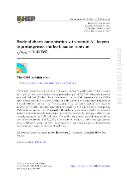Study of charm hadronization with prompt Λc+ baryons in proton-proton and lead-lead collisions at √sNN=5.02 TeV

Author
Tumasyan, A.
Adam, W.
Andrejkovic, J. W.
Bergauer, T.
Chatterjee, S.
Damanakis, K.
Dragicevic, M.
Del Valle, A. Escalante
Hussain, P. S.
Jeitler, M.
Publication date
2024Published in
Journal of High Energy PhysicsVolume / Issue
neuveden (1)ISBN / ISSN
ISSN: 1029-8479Metadata
Show full item recordCollections
This publication has a published version with DOI 10.1007/JHEP01(2024)128
Abstract
The production of prompt Lambda(+)(c) baryons is measured via the exclusive decay channel Lambda(+)(c) -> pK(-) pi(+) at a center-of-mass energy per nucleon pair of 5.02TeV, using proton-proton (pp) and lead-lead (PbPb) collision data collected by the CMS experiment at the CERN LHC. The pp and PbPb data were obtained in 2017 and 2018 with integrated luminosities of 252 and 0.607 nb(-1), respectively. The measurements are performed within the Lambda(+)(c) rapidity interval vertical bar y vertical bar < 1 with transverse momentum (p(T)) ranges of 3-30 and 6-40 GeV/c for pp and PbPb collisions, respectively. Compared to the yields in pp collisions scaled by the expected number of nucleon-nucleon interactions, the observed yields of Lambda(+)(c) with p(T) > 10 GeV/c are strongly suppressed in PbPb collisions. The level of suppression depends significantly on the collision centrality. The Lambda(+)(c)/D-0 production ratio is similar in PbPb and pp collisions at p(T) > 10 GeV/c, suggesting that the coalescence process does not play a dominant role in prompt Lambda(+)(c) baryon production at higher p(T).
Keywords
Heavy Ion Experiments, Heavy Quark Production, Relativistic Heavy Ion Physics, CMS
Permanent link
https://hdl.handle.net/20.500.14178/3015License
Full text of this result is licensed under: Creative Commons Uveďte původ 4.0 International






